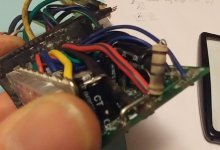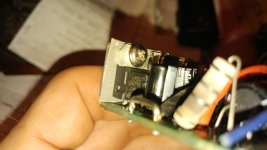EV_Ron
100 mW
Background (questions below):
Last week, found burned R1, possibly FETs 1&2, 36V on a KU63/65 after 7 years and maybe 1000 miles. Death took about 4 days... Motor 1st cutting out after 20 minutes, then 10 minutes, 2 minutes then....just tick....tick. (Yes, will replace 100 Ω resistor once I find one... Wasn't there a place called Radio Shack???
Needed a controller for testing so bought the only controller with connector for a display that I could get quickly (surprising how difficult/near impossible it is to find controllers sold alone that have a display cable. But, found Wal-Mart has a GREAT listing of controllers, better than eBay, Amazon, Sears, and Aliexpress combined, 100s of them! Check it out. I'm also now aware you can add a display cable to almost any controller because most have the signals on the PCB. Might be useful to someone.)
Anyway, bought an Ebikeling 36/48V 500W controller (yes, I know 22A capable) for use with 36V 10Ah batt, 2014 LCD 3 and Q100 (yes, I know 12-18A max by tinning the KU65 shunt.) I attempted to turn power down by setting C5=3, or so I thought; and therein lies the problem- that's BMSBattery C5, and ebikeling S830 LCD display manual doesn't even mention C settings . So, their controller probably doesn't understand them.
. So, their controller probably doesn't understand them.
Regardless, the ebikeling 500W controller drives the Q100 smoothly on throttle, both sensored & sensorless, and they even work in pedal assist... except PAS is set to 0 in the display (hmmm, 1st clue: PAS shouldn't work at all if PAS=0).
Here's the big clue that controller & display aren't communicating well: LCD 3 display shows 41V in lower right corner (which must be an AD measurement inside the LCD3 display), but MPH, battery icon charge level, W, and battery temp are all blank on the LCD3, and I assume all 4 are controller values 'transmitted' from the controller to the display. (Yes, I've checked pinouts: swapped 2 sensor pins in the Hall plug which made the Q100 run sensored, and everything else aligns.)
Questions:
Would someone please validate this logic & correct me of I'm wrong: the old LCD3 display and this new ebikeling 36/48 500W controller don't communicate well if at all because the LCD 3 display only knows parameters P1-5 (P5=15 of course being 36V voltage level) and the ebikeling controller expects an LCD 830 display and communicates P1-16, e.g. requiring "P03 the parameter to set Voltage Class: 24V /36V / 48V." (P3 for the LCD 3 is PAS mode, 0 or 1.)
And, they will never communicate correctly, right? (IOW, the KT LCD3 is not interchangeble with a the ebikeling LCD.)
Are ebikeling controllers made by KT?
Can you flash an LCD 3 to work with an ebikeling controller sp. its 16 parameters?
Does anyone do it (doesn't appear so, there's not a single post about it), or should I just fix/buy a KU65?
can you recommend another controller to replace the KU65 (I had a KU63/65 Type I=3 PAS levels).
Bottom line, I assume the new controller is defaulting to "48V battery" and therefore even 41V full charge is empty, which it "transmits" to the display, if any data is sent at all. Controller probably sends mph, temp, and power, too, but the 5-parameter KT LCD 3 doesn't understand the 16-parameter data stream.
Strange thing is, if I temporarily set P5 to 0 in the LCD 3, as others have done, battery shows full, as others have found.
Thanks
P.S.
I have searched battery icon blank, Ebikeling controllers etc, but nowhere did I find a mention about 16 parameter controllers, nor about differing parameter sets being a reason for non-communication, only incompatible displays & controllers. And, I've seen lots of discussion about flashing the LCD 3 to work with the TSDZ2 & Bafang MDM's internal controllers, but nothing about making it work with other controllers.
Yes, I've read as many of Amberwolf's posts on empty or half full battery symbols as I can, but nothing regarding parameters/ comms mismatch. I'm now starting to read casainho's posts on flashing the LCD 3, but I gather it's all in reference to the TSDZ2.
Last week, found burned R1, possibly FETs 1&2, 36V on a KU63/65 after 7 years and maybe 1000 miles. Death took about 4 days... Motor 1st cutting out after 20 minutes, then 10 minutes, 2 minutes then....just tick....tick. (Yes, will replace 100 Ω resistor once I find one... Wasn't there a place called Radio Shack???
Needed a controller for testing so bought the only controller with connector for a display that I could get quickly (surprising how difficult/near impossible it is to find controllers sold alone that have a display cable. But, found Wal-Mart has a GREAT listing of controllers, better than eBay, Amazon, Sears, and Aliexpress combined, 100s of them! Check it out. I'm also now aware you can add a display cable to almost any controller because most have the signals on the PCB. Might be useful to someone.)
Anyway, bought an Ebikeling 36/48V 500W controller (yes, I know 22A capable) for use with 36V 10Ah batt, 2014 LCD 3 and Q100 (yes, I know 12-18A max by tinning the KU65 shunt.) I attempted to turn power down by setting C5=3, or so I thought; and therein lies the problem- that's BMSBattery C5, and ebikeling S830 LCD display manual doesn't even mention C settings
Regardless, the ebikeling 500W controller drives the Q100 smoothly on throttle, both sensored & sensorless, and they even work in pedal assist... except PAS is set to 0 in the display (hmmm, 1st clue: PAS shouldn't work at all if PAS=0).
Here's the big clue that controller & display aren't communicating well: LCD 3 display shows 41V in lower right corner (which must be an AD measurement inside the LCD3 display), but MPH, battery icon charge level, W, and battery temp are all blank on the LCD3, and I assume all 4 are controller values 'transmitted' from the controller to the display. (Yes, I've checked pinouts: swapped 2 sensor pins in the Hall plug which made the Q100 run sensored, and everything else aligns.)
Questions:
Would someone please validate this logic & correct me of I'm wrong: the old LCD3 display and this new ebikeling 36/48 500W controller don't communicate well if at all because the LCD 3 display only knows parameters P1-5 (P5=15 of course being 36V voltage level) and the ebikeling controller expects an LCD 830 display and communicates P1-16, e.g. requiring "P03 the parameter to set Voltage Class: 24V /36V / 48V." (P3 for the LCD 3 is PAS mode, 0 or 1.)
And, they will never communicate correctly, right? (IOW, the KT LCD3 is not interchangeble with a the ebikeling LCD.)
Are ebikeling controllers made by KT?
Can you flash an LCD 3 to work with an ebikeling controller sp. its 16 parameters?
Does anyone do it (doesn't appear so, there's not a single post about it), or should I just fix/buy a KU65?
can you recommend another controller to replace the KU65 (I had a KU63/65 Type I=3 PAS levels).
Bottom line, I assume the new controller is defaulting to "48V battery" and therefore even 41V full charge is empty, which it "transmits" to the display, if any data is sent at all. Controller probably sends mph, temp, and power, too, but the 5-parameter KT LCD 3 doesn't understand the 16-parameter data stream.
Strange thing is, if I temporarily set P5 to 0 in the LCD 3, as others have done, battery shows full, as others have found.
Thanks
P.S.
I have searched battery icon blank, Ebikeling controllers etc, but nowhere did I find a mention about 16 parameter controllers, nor about differing parameter sets being a reason for non-communication, only incompatible displays & controllers. And, I've seen lots of discussion about flashing the LCD 3 to work with the TSDZ2 & Bafang MDM's internal controllers, but nothing about making it work with other controllers.
Yes, I've read as many of Amberwolf's posts on empty or half full battery symbols as I can, but nothing regarding parameters/ comms mismatch. I'm now starting to read casainho's posts on flashing the LCD 3, but I gather it's all in reference to the TSDZ2.




